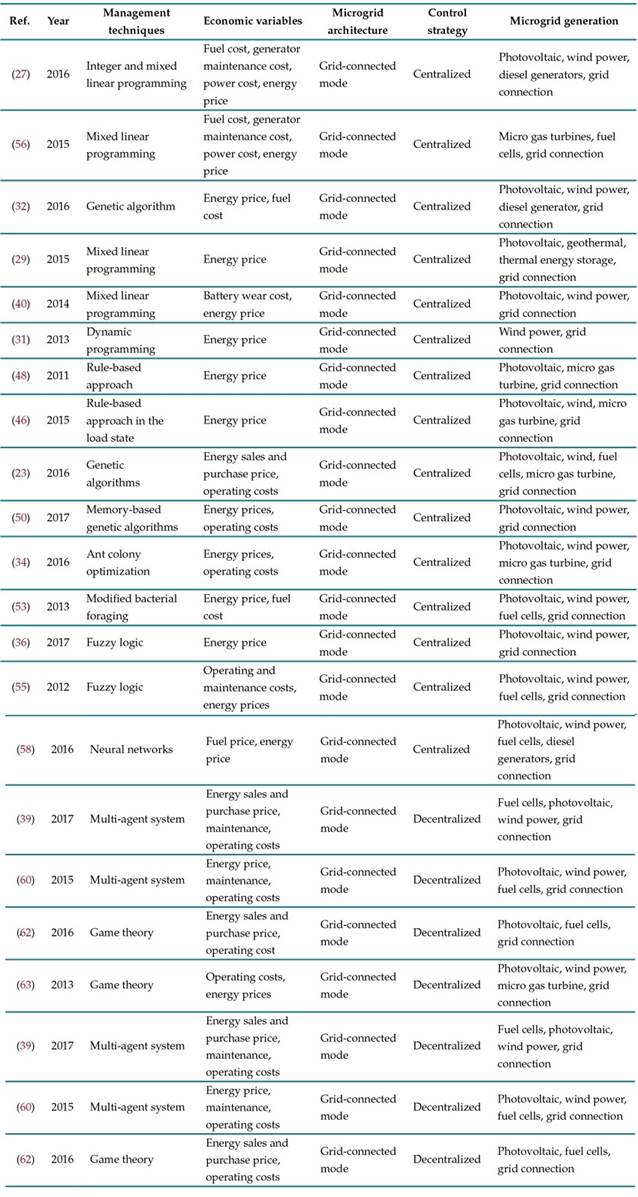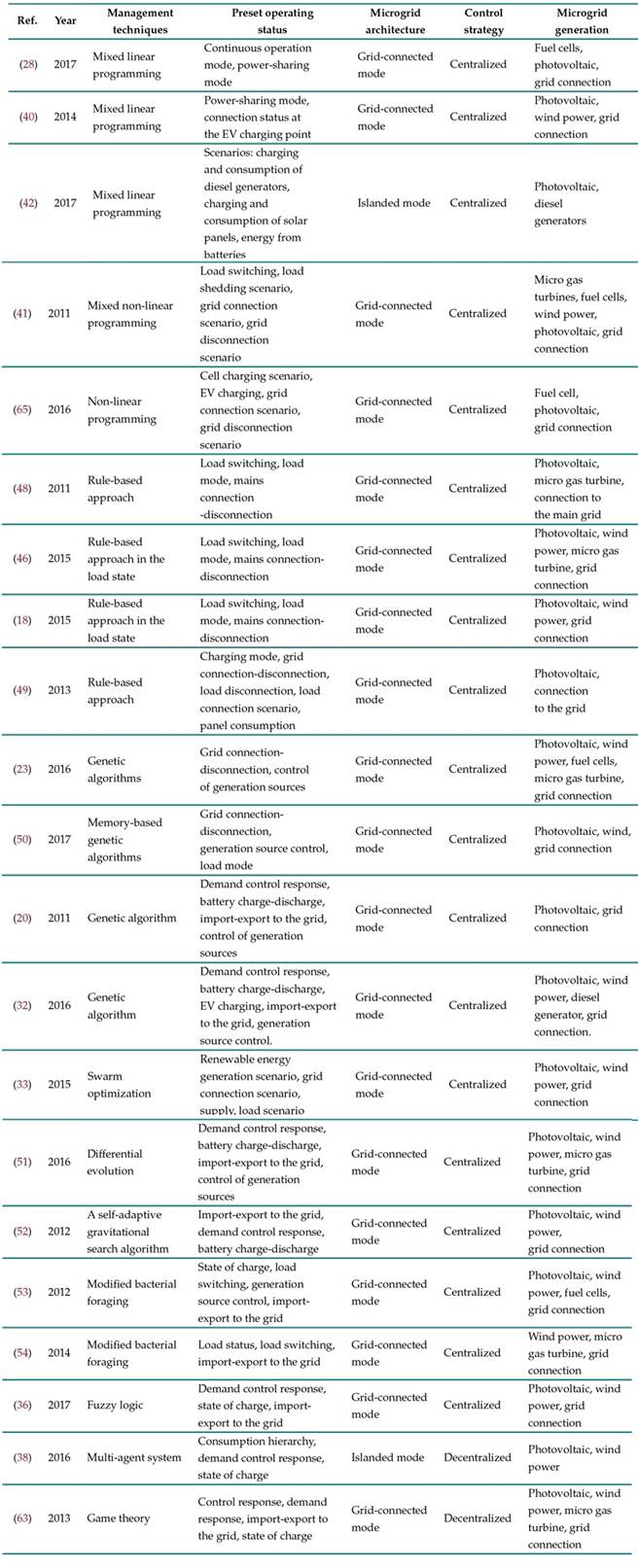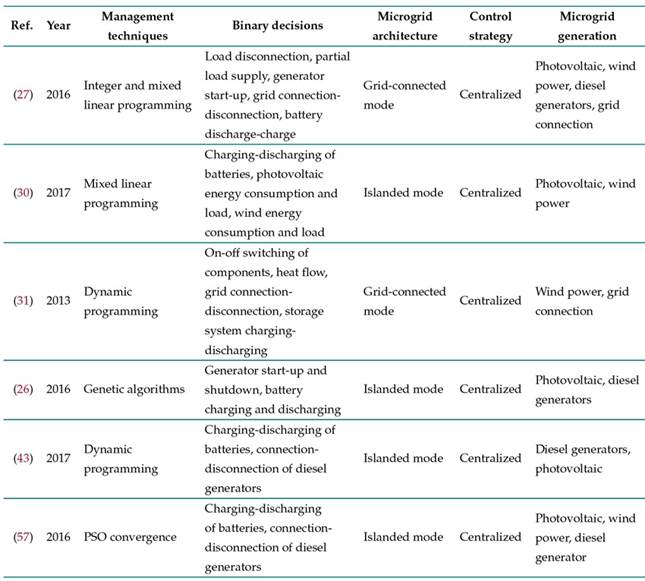Introduction
Since the emergence of microgrids, the incidence of renewable energies in the energy landscape has increased 1. A microgrid consists of the interconnection of loads of different nature, communication systems, metering, control, and distributed energy sources. This system can operate in standalone mode and connect with other microgrids or the main power grid 1), (2. A microgrid has the following sections: a physical plant where the distributed energy components are located (generation and storage elements, load groups, flexible loads, smart loads, and protection and connection elements); a control section, which governs the components of the physical plant and may be centralized (the management system controls the microgrid as a single entity) or decentralized (the control of each component is independent); and a management section, where the flow of energy depends on data from inside and outside the microgrid, according to specific objectives 3 (Fig. 1). Microgrids have become more relevant due to changes in regulatory aspects 4 and the cost reduction of different components 5. These characteristics have also led to increased research aimed at solving various problems associated with these systems 6, particularly focusing on the development of a good energy management system (EMS) 7).
The first publications on microgrids date back to the early 2000s 8, which could be counted by the dozen. Nowadays, publications amount to approximately 1.500 articles per year 9. A wide variety of factors affect microgrids, such as generation, energy demand, storage status, and the cost of energy, without omitting any regulations that apply. These factors must be synchronized and managed in order to ensure the most efficient operation 10), (11. To this effect, a microgrid must have a suitable local generation system that allows it to operate in any scenario (desired and undesired) 12.
Different approaches have studied the problems associated with energy resource management 13, 14. A variety of research works focus on microgrid control methods and configurations 15, management system functionalities 16, architectures and the components to be controlled 17, and input and output variables. Different objectives and factors influence microgrid energy flow 18. However, these works have not reached unanimity on these aspects. Therefore, a systematic compilation of these works is necessary, in addition to a clear definition of the state of research on EMS for this type of grid.
This paper presents a descriptive review of the factors involved in the management system of a microgrid, such as input and output variables, topology configurations, and the control method and strategy. This review seeks to be a reference tool that will be available for all those interested in working on microgrid energy management to find a compendium of the main components in this type of system.
The structure of this paper is as follows: Section 2 presents the concept of a microgrid management system; Section 3 explains the variables involved in a microgrid management system; Section 4 presents them; and Section 5 provides some conclusions based on the collected information.
Microgrid management systems
In IEC 61970, the International Electrotechnical Commission defines a management system in electrical environments as ”a computer program comprising a software platform that provides basic support services and a set of applications providing the functionality necessary for the efficient operation of electrical generation and transmission facilities to ensure adequate security of power supply at minimum cost" 19. A microgrid management system generally consists of modules such as energy resource distribution and load forecasting systems, human-machine interfaces, and supervisory control and data acquisition (SCADA) systems, which ensure the efficient implementation of decision-making strategies by sending orders to generation, storage, and load unit components 20. The management system performs various functions, such as monitoring, analyzing, and forecasting power generation from distributed energy resources, load consumption, energy market prices, auxiliary markets, and meteorological factors. These functions help the management system improve the microgrid’s performance while compensating for its limitations 21.
Management systems implement one of two control strategies: centralized and decentralized. In the centralized one, a central controller accumulates information from the energy resources distribution and load forecasting modules, such as meteorological and energy data and user consumption patterns, among others. These data enter the SCADA module, which determines the energy programming of the microgrid and sends orders to the local controller, which is in charge of executing them in the different components of the microgrid 15. In contrast, in the decentralized control strategy, the central microgrid controller sends and receives all information from the local controllers of the microgrid components in real time. Each local controller proposes a current and future order to the central controller of the microgrid, and the central controller determines the most beneficial scheduling and delivers it to the local controllers. The latter may disagree with the current operation and may continue negotiating until global and local objectives are achieved 22.
With the integration of renewable energy resources, storage systems, electric vehicles, and demand response, the objectives of microgrid management systems have diversified, e.g., scheduling distributed energy resources and loads, minimizing system losses and outages, controlling the intermittency and volatility of renewable energy resources, and achieving economical, sustainable, and reliable operation for the microgrid 16.
Variables involved in a microgrid management system
Unlike traditional power systems, in a microgrid, it is possible to evaluate multiple variables thanks to the installation of smart meters and a better knowledge of the system’s operation. These variables can be inputs or outputs of the management system.
Management system inputs
Different works focused on implementing EMS 23)-(26 show the diverse use of input variables and different alternatives in decision-making.
The input variables can be divided into three categories:
External variables
The external inputs of the microgrid are related to the factors that influence energy generation and are usually of a meteorological nature. They change with respect to the type of renewable energy used.
For photovoltaic energy, the relevant variables are
For wind energy, there is
The external variables can be subdivided into two new categories:
Meteorological
In 28)-(32, the authors use solar irradiance, temperature, and wind speed as external variables of a meteorological nature. Uncertainty prediction methods establish the variable values to obtain an approximation of the microgrid’s energy and ability to supply the demand of its loads. Although these references share these common aspects, they implement different architectures, generation systems, strategies, and control methods 16. Although there is a difference in generation sources, the treatment of information and the obtention methods are similar. A general review of this subject is presented in Table I.
The most relevant meteorological variables are solar irradiance, temperature, and wind speed. Fig. 2 shows the use percentage of these variables. Irradiance is the most frequently mentioned due to the technological advances for measuring it and the availability of official information in some countries. Methods based on artificial intelligence have led the field by predicting behavior and due to their ability to use large volumes of data to estimate the generation potential.

Figure 2 a) Relevant meteorological variables, b) management techniques relevant to meteorological variables
Generation system power
In several works 18),(40)-(46, the variables used by the management system involve the output power of the generation systems in order to determine the maximum power that can be supplied via historic data or by directly measuring the output power. Hence, they only consider the result of the microgrid’s energy generation (Table II).

Figure 3 a) Relevant power generation system variables, b) relevant management techniques regarding the power variables of generation systems
Internal variables
The information handled by the internal variables is electrical. Within this category the following groups can be mentioned:
The state of charge and capacity of the storage system
The state of charge of an electric vehicle
The power output of the generation or prediction
The frequency of the generated power
Load demand, smart loads, and flexible loads
There are two subcategories:
Priority loads
Within this category, 27), (28), (42), (43), (48), and 56 control variables that are inherent to the mi- crogrid. There are loads with a degree of priority, as the network is operated via a management system with a hierarchy of consumption. This system prioritizes the supply of loads with a higher value regard- ing decision-making (Table III).
The most relevant variables used in this category are shown in Fig. 4.

Figure 4 a) Relevant variables of priority loads, b) relevant management techniques for priority load variables
Controllable loads
In 10), (48), (50)-(52, the implementation of controllable or intelligent loads that help to prevent the network from overloading or destabilizing also facilitates communication with the management system. This configuration allows the EMS to adjust the power supplied or the actions to be taken from a predetermined range of parameters. Thus, the loads can operate partially, preserving their primary functions (Table IV).
Economic variables
The economic variables of the microgrid are mainly related to its operation and maintenance costs, e.g.,
This financial information is usually obtained through energy sales exchanges 61 and has two sub-categories:

Figure 5 a) Relevant variables of controllable loads, b) relevant management techniques for controllable load variables
Energy value
As per 29),(30),(33),(46, and (?), this category has associated operating costs and values, with particular emphasis on the energy price. The energy value generated can be similar to the energy price for the time during which the microgrid operates autonomously. This results in a saving that justifies the resources spent, contributing to the viability of the microgrid’s implementation (Table V).
The most relevant variables used in this category are shown in Fig. 6.

Figure 6 a) Economic variables regarding energy value, b) relevant management techniques regarding energy value
Cost of generation
In 26), (30), (42, and 43, factors such as the fuel or generation cost, the operating costs, and the maintenance costs of the microgrid take on greater relevance. The price of energy supplied by the conventional power grid is not considered by these authors, as the microgrid operates in islanded mode (Table VI).
The most relevant variables used in this category are shown in Fig. 7.

Figure 7 a) Economic variables regarding the cost of generation, b) relevant management techniques for economic variables regarding the cost of generation
Management system outputs
A management system’s output is the instruction or orders that the system executes to fulfill an objective. These instructions influence the routing of the energy flow and the operation or shutdown of components.
The outputs of the management system can be divided into two categories:
A. Preset operating status
28), (41)-(43, and 48 propose, as outputs of their management systems, pre-defined scenarios that are activated when the microgrid parameters reach previously defined values. These scenarios focus on directing the energy flow to meet a specific objective, maintaining the microgrid in islanded mode, feeding the storage components, or reducing the demand of the loads, among others (Table VII)
The most relevant variables used in this category are shown in Fig. 8.

Figure 8 a) Output variables for the preset operating status, b) relevant management techniques regarding the output variables for the preset operating status
B. Binary decisions
In 26), (27), (30, and 43, the management systems’ outputs correspond to the connection or disconnection of microgrid elements, as well as to the flow of energy (Table VIII).
The most relevant variables used in this category are shown in Fig. 9.
Analysis
This systematic review shows the importance of microgrid components and their influence on the data to be considered by the management system. The importance is primarily evident in the type of generation of the microgrid, where solar irradiance is the most relevant input of the external category. The meteorological subsection, which pertains to more than 40 % of the papers studied, shows a more effective implementation in microgrids that have photovoltaic generation sources. The same trend is visible in the category of external variables related to generation power, where photovoltaic power prediction is the most recurrent, with 31 % of the papers studied. This also applies to the category of external variables, with wind speed being the second most relevant meteorological variable (31 %). Similarly, for generation power, wind energy prediction variable is present in 19 % of the papers studied, which contrasts with the implementation of microgrids that use fossil fuels as generation sources, (5 %). This can be better seen in Fig. 10a. These results show a clear trend regarding the implementation of renewable energies in microgrids.

Figure 10 a) Microgrid generation in the reviewed papers, b) microgrid control strategies in the reviewed papers
Although some microgrid components influence the data used by the EMS, there is no significant impact. The methods for collecting and processing data are so varied that they do not reflect a significant statistical difference in the inputs and outputs of the management system. On the other hand, a more effective implementation of centralized control strategies is noticeable, which is present in 83 % of the papers studied (Fig. 10b). A meticulous analysis of the papers’ year of publication shows a trend towards decentralized control strategies. This may be due to the fact that these strategies are more flexible and ensure a better fulfillment of the objectives, although the computational effort and resources required are more significant 16. The control techniques implemented by the management systems of the studied papers are so varied that they do not represent a significant statistical difference, as seen in Fig. 11a.
The inputs follow the needs of the management system modules and the specific components of the microgrid. This need is evident since more than 90 % of the papers studied implement some type of storage system, mainly batteries, whose state of charge and storage capacity are used for monitoring. The other variables in this category depend more on the type of loads that the microgrid must supply. The economic variables depend primarily on the microgrid architecture, as they are directly related to the connection to the main grid or other microgrids. If the microgrid is islanded, the economic variables focus on the costs of operation and the fuel prices, given that diesel generators or similar resources are used to guarantee a constant flow of energy. The connection with the primary grid entails a focus on the energy sales price and the operating costs. This type of architecture is the most used in the analyzed papers (78 %) (Fig. 11b).

Figure 11 a) Microgrid control strategies in the reviewed papers, b) microgrid architecture in the reviewed papers
The output variables do not show any direct relationship with the EMS modules studied when compared to the input variables. The outputs depend more on how the author wants decision-making to take place, e.g., by having binary decisions involving the connection or disconnection of microgrid components. Decisions on the generation and autonomy of the microgrid are the most implemented when compared to those aimed at managing the demand.
Conclusions
This review article started with a brief description of the management systems applied to microgrids, in order to determine the functions they should perform. With these definitions, the data to be collected and its associated variables were determined, which would be the input for a correct EMS performance. With these variables as a basis, an analysis of their properties was conducted. The variables that shared properties were grouped into categories while considering the functions for which they provide information. In light of the above, this article proposes a taxonomy for the input and output variables of a microgrid management system.
Progress has been made in microgrid management using different control and management techniques and strategies, evaluating their pros and cons. However, it is relevant to consider other factors that may affect performance, such as the nature of the variables and the topology of the microgrid, among others.
It is important to know the variables that serve as the inputs and outputs of management systems in order to ensure a good microgrid performance. In this vein, this paper helps those interested in delving into the implementation of these systems. The proposed taxonomy could serve as a guide to perform the conceptual and basic engineering of projects in this sector.
Given that most of the papers studied used simulation environments, it is also necessary to test management systems in real-world scenarios to evaluate their effects and performance

























